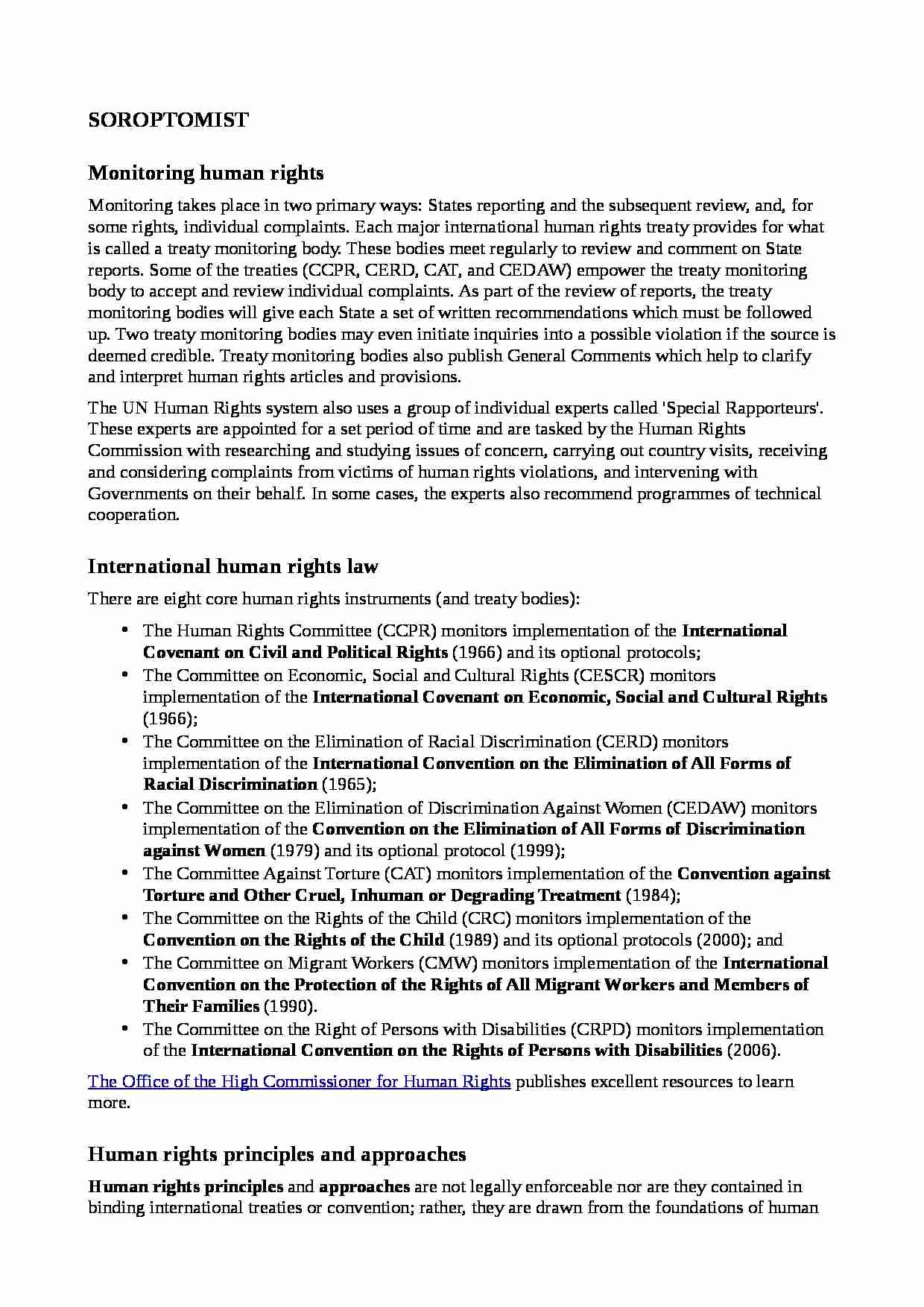To tylko jedna z 2 stron tej notatki. Zaloguj się aby zobaczyć ten dokument.
Zobacz
całą notatkę


SOROPTOMIST Monitoring human rights Monitoring takes place in two primary ways: States reporting and the subsequent review, and, for some rights, individual complaints. Each major international human rights treaty provides for what is called a treaty monitoring body. These bodies meet regularly to review and comment on State reports. Some of the treaties (CCPR, CERD, CAT, and CEDAW) empower the treaty monitoring body to accept and review individual complaints. As part of the review of reports, the treaty monitoring bodies will give each State a set of written recommendations which must be followed up. Two treaty monitoring bodies may even initiate inquiries into a possible violation if the source is deemed credible. Treaty monitoring bodies also publish General Comments which help to clarify and interpret human rights articles and provisions.
The UN Human Rights system also uses a group of individual experts called 'Special Rapporteurs'. These experts are appointed for a set period of time and are tasked by the Human Rights Commission with researching and studying issues of concern, carrying out country visits, receiving and considering complaints from victims of human rights violations, and intervening with Governments on their behalf. In some cases, the experts also recommend programmes of technical cooperation.
International human rights law There are eight core human rights instruments (and treaty bodies):
The Human Rights Committee (CCPR) monitors implementation of the International Covenant on Civil and Political Rights (1966) and its optional protocols; The Committee on Economic, Social and Cultural Rights (CESCR) monitors implementation of the International Covenant on Economic, Social and Cultural Rights (1966); The Committee on the Elimination of Racial Discrimination (CERD) monitors implementation of the International Convention on the Elimination of All Forms of Racial Discrimination (1965); The Committee on the Elimination of Discrimination Against Women (CEDAW) monitors implementation of the Convention on the Elimination of All Forms of Discrimination against Women (1979) and its optional protocol (1999); The Committee Against Torture (CAT) monitors implementation of the Convention against Torture and Other Cruel, Inhuman or Degrading Treatment (1984); The Committee on the Rights of the Child (CRC) monitors implementation of the Convention on the Rights of the Child (1989) and its optional protocols (2000); and The Committee on Migrant Workers (CMW) monitors implementation of the International Convention on the Protection of the Rights of All Migrant Workers and Members of Their Families (1990). The Committee on the Right of Persons with Disabilities (CRPD) monitors implementation of the International Convention on the Rights of Persons with Disabilities (2006).
(…)
… (2006).
The Office of the High Commissioner for Human Rights publishes excellent resources to learn more.
Human rights principles and approaches
Human rights principles and approaches are not legally enforceable nor are they contained in binding international treaties or convention; rather, they are drawn from the foundations of human rights and illustrate the concepts that give rise to the legal rights. Principles and approaches are often used in the development of policies, laws, programmes, and projects. These include participation, non-discrimination, safeguarding dignity, paying particular attention to vulnerable groups, being transparent, and other similar concepts that all human rights have in common. We must be careful to differentiate between human rights principles and approaches and…
... zobacz całą notatkę




Komentarze użytkowników (0)